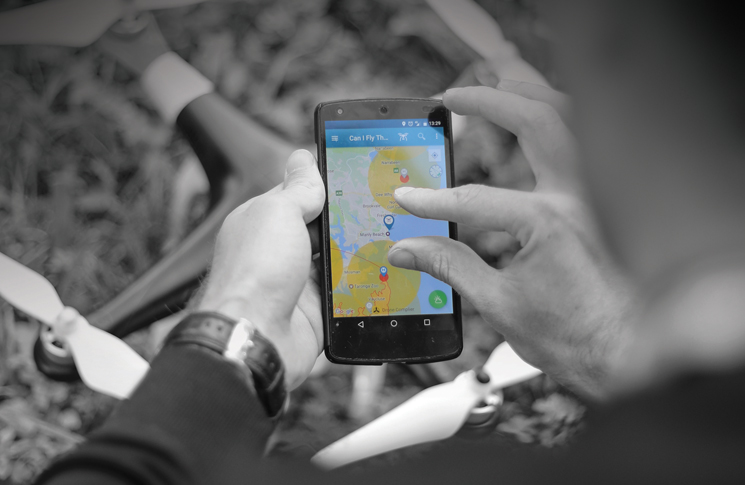Drone technology promises much for society. It also means a minority of operators breaking the rules and getting fined for their troubles.
Want to see the revolution in aviation? Go to your local electronics shop. On its aisles, somewhere between headphones and televisions, you can find an aircraft capable of flying at 6000 ft. You don’t even need a licence to fly it. But there are rules (including one that says you can’t go anywhere near as high as 6000 ft), and as a few foolish flyers have found, there are consequences for breaking them.
Remotely piloted aircraft, commonly known as drones, mean more people are piloting aircraft than ever before. Like any activity involving the broader population, such as driving a car, most follow the rules—a few don’t. They risk being fined by CASA, the police and other state government authorities.
Whether operating in restricted areas like Sydney Harbour, too close to other people at a wedding or flying over a Supercar race in Townsville, there seems to be a rogue drone operator in the news every week.
CASA has issued 20 infringement notices in 2017 to date, with the most common breaches for flying too close to other people or in controlled airspace or restricted areas without first gaining permission.
One operator managed both of these breaches in a single flight, fined $540 for flying in Sydney Harbour and $900 for flying within 30 metres of other people.
Flying over populous areas is another common pitfall for many drone operators who either don’t know or don’t understand the intent of the safety rules.
Civil aviation safety regulation (CASR) Part 101 is designed to protect other people in the air and on the ground. While there is a requirement for operators to keep their drone 30 metres away from other people, they must also not fly over an area—where if their drone was to fail—it could hit someone.
This was the case in April 2016, when a recreational operator was fined $900 for flying over the Australian War Memorial. Not only was he flying during a last-post ceremony (while not illegal, it’s certainly in bad taste), he also managed to crash at the feet of the memorial’s director, who promptly handed it to security. More recently, the populous rule cost another Canberra drone pilot $900 for flying over an Easter egg hunt ‘at a height from which if the drone malfunctioned it would not have been able to clear the area.’
While CASA’s RPAS team aims to take an ‘education-first’ approach when conducting enforcement, if the operator has created a hazard to another person or airspace user, they are likely to receive an aviation infringement notice.
CASA’s Director of Aviation Safety, Shane Carmody, recently said fines would continue
to be issued where people break the drone safety rules.
‘The rules protect people, property and aircraft from drones,’ Carmody says. ‘If you fly a drone it is your responsibility to fly by the rules and stay safe at all times.’
From July 2017, these fines have also increased, with infringement notices ranging from $210 to $1050 for each offence if the person is convicted or found guilty by a court. Particularly serious breaches of Part 101 can also be referred the Director of Public Prosecutions, and courts can impose maximum fines as high as $10,500 per offence.
For those reckless or oblivious enough to threaten the safety of another aircraft, there are also Section 20A (reckless operation of an aircraft) and Section 24 (acts endangering an aircraft) of Civil Aviation Act 1988, with a maximum penalty of five years in prison.
But it’s not just aviation safety regulations drone operators need to consider when flying, as a 17-year-old recently discovered in Townsville, Queensland. Taking to the skies over a recent Supercar race, the teenager allegedly breached Section 29 of the Major Events Act 2014, a Queensland law, which designates the airspace over a major event as a restricted area. He now faces court and a maximum fine in the thousands of dollars.
State-based legislation also applies when it comes to flying near whales, dolphins and other marine mammals, with environmental authorities setting out minimum approach distances for all aircraft—including drones.

In NSW the National Parks and Wildlife Regulation 2009 requires all drone operators to keep at least 300 metres away from marine mammals, with operators risking a $300 on-the-spot fine for non-compliance. Under this legislation, serious breaches can also attract a maximum penalty of $110,000. While there have been no recorded cases of fines being issued in Australia, a drone pilot was fined $US1000 in 2015 for getting too close to a pod of orcas near Washington State in the US.
While the effectiveness of issuing fines to rogue operators is often debated in public—with arguments to both increase and decrease the amounts involved—there is little doubt these high-profile cases have done two things.
Firstly, they have reached millions of people through social and mainstream media, raising awareness around the drone safety rules; constantly reminding drone operators of the consequences they face if they choose to fly beyond the law.
Secondly, they have stimulated a public discussion about whether the recreational drone rules need to change, requiring new drone owners to register their details and complete a basic training course before taking to the skies.
CASA is currently conducting a Drone Safety Review addressing these questions and has released a discussion paper on the topic, calling for feedback from the aviation industry and the wider general public.
CASA recently released the ‘Can I fly there?’ drone safety app, showing operators where they can’t fly in an easy-to-use smartphone app. At the time of writing the app has been downloaded and used by just under 80,000 people.




Comments are closed.